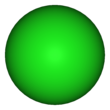
| |||
| |||
| Names | |||
|---|---|---|---|
| IUPAC name Carbamimidoylazanium chloride | |||
| Other names Guanidine hydrochloride | |||
| Identifiers | |||
| CAS Number | |||
| 3D model (JSmol) | |||
| ChEBI | |||
| ChemSpider | |||
| ECHA InfoCard | 100.000.003 | ||
| KEGG | |||
| PubChem CID | |||
| UNII | |||
| CompTox Dashboard (EPA) | |||
InChI
| |||
SMILES
| |||
| Properties | |||
| Chemical formula | CH6ClN3 | ||
| Molar mass | 95.53 g·mol | ||
| Appearance | Orthorhombic bipyramidal crystals | ||
| Density | 1.354 g/cm at 20 °C | ||
| Melting point | 182.3 °C (360.1 °F; 455.4 K) | ||
| Solubility in water | 2.15 g/ml at 20 °C | ||
| Acidity (pKa) | 13.6 | ||
| Hazards | |||
| Safety data sheet (SDS) | External MSDS | ||
| Except where otherwise noted, data are given for materials in their standard state (at 25 °C , 100 kPa).
| |||
Guanidinium chloride or guanidine hydrochloride, usually abbreviated GdmCl and sometimes GdnHCl or GuHCl, is the hydrochloride salt of guanidine.
Structure
Guanidinium chloride crystallizes in orthorhombic space group Pbca. The crystal structure consists of a network of guanidinium cations and chloride anions linked by N–H···Cl hydrogen bonds.
Acidity
Guanidinium chloride is a weak acid with a pKa of 13.6. The reason that it is such a weak acid is the complete delocalisation of the positive charge through 3 nitrogen atoms (plus a little bit positive charge on carbon). However, some stronger bases can deprotonate it, such as sodium hydroxide:
The equilibrium is not complete because the acidity difference between guanidinium and water is not large (The approximate pKa values: 13.6 vs 15.7).
Complete deprotonation should be done with extremely strong bases, such as lithium diisopropylamide.
Use in protein denaturation
Guanidinium chloride is a strong chaotrope and one of the strongest denaturants used in physiochemical studies of protein folding. It also has the ability to decrease enzyme activity and increase the solubility of hydrophobic molecules. At high concentrations of guanidinium chloride (e.g., 6 M), proteins lose their ordered structure, and they tend to become randomly coiled, i.e. they do not contain any residual structure. However, at concentrations in the millimolar range in vivo, guanidinium chloride has been shown to "cure" prion positive yeast cells (i.e. cells exhibiting a prion positive phenotype revert to a prion negative phenotype). This is the result of inhibition of the Hsp104 chaperone protein known to play an important role in prion fiber fragmentation and propagation.
Historical survey
Petrunkin and Petrunkin (1927, 1928) appear to be the first who studied the binding of GnHCl to gelatin and a mixture of thermally denatured protein from brain extract. Greenstein (1938, 1939), however, appears to be the first to discover the high denaturing action of guanidinium halides and thiocyanates in following the liberation of sulfhydryl groups in ovalbumin and other proteins as a function of salt concentration.
Medical uses
Guanidine hydrochloride is indicated for the reduction of the symptoms of muscle weakness and easy fatigability associated with Eaton-Lambert syndrome. It is not indicated for treating myasthenia gravis. It apparently acts by enhancing the release of acetylcholine following a nerve impulse. It also appears to slow the rates of depolarization and repolarization of muscle cell membranes. Initial dosage is usually between 10 and 15 mg/kg (5 to 7 mg/pound) of body weight per day in 3 or 4 divided doses. This dosage may be gradually increased to a total daily dosage of 35 mg/kg (16 mg/pound) of body weight per day or up to the development of side effects. Side effects may include increased peristalsis, diarrhea, paresthesia (tingling and numbness), and nausea. Fatal bone-marrow suppression, apparently dose related, can occur with guanidine.
References
- "Icsc 0894 - Guanidine Hydrochloride".
- ^ "BioSpectra - Guanidine Hydrochloride". biospectra.us. Retrieved 2017-06-08.
- Ferreira PC, Ness F, Edwards SR, Cox BS, Tuite MF (2001) The elimination of the yeast prion by guanidine hydrochloride is the result of Hsp104 inactivation. Mol Microbiol 40 (6):1357-1369.
- Ness F, Ferreira P, Cox BS, Tuite MF (2002) Guanidine hydrochloride inhibits the generation of prion "seeds" but not prion protein aggregation in yeast. Mol Cell Biol 22 (15):5593-5605.
- Eaglestone SS, Ruddock LW, Cox BS, Tuite MF (2000) Guanidine hydrochloride blocks a critical step in the propagation of the prion-like determinant of Saccharomyces cerevisiae. Proc Natl Acad Sci USA 97 (1):240-244.
- Lapange, Savo (1978). Physicochemical aspects of protein denaturation. New York: Wiley. ISBN 0-471-03409-6.
- Wiederholt, W. C. (1975). "Guanidine hydrochloride therapy in neuromuscular disorders". Western Journal of Medicine. 123 (2): 132–133. PMID 1179724.



